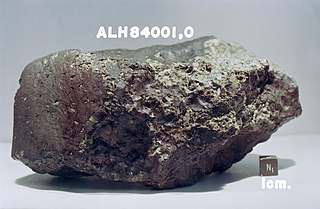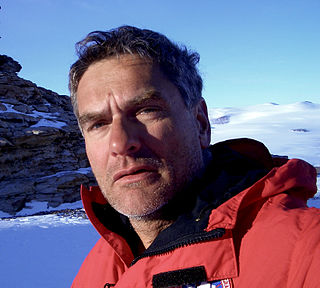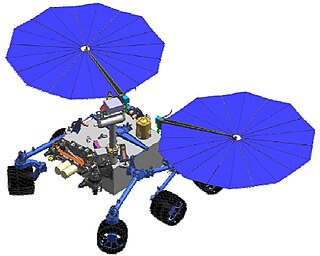
Astrobiology is a scientific field within the life and environmental sciences that studies the origins, early evolution, distribution, and future of life in the universe by investigating its deterministic conditions and contingent events. As a discipline, astrobiology is founded on the premise that life may exist beyond Earth.

Allan Hills 84001 (ALH84001) is a fragment of a Martian meteorite that was found in the Allan Hills in Antarctica on December 27, 1984, by a team of American meteorite hunters from the ANSMET project. Like other members of the shergottite–nakhlite–chassignite (SNC) group of meteorites, ALH84001 is thought to have originated on Mars. However, it does not fit into any of the previously discovered SNC groups. Its mass upon discovery was 1.93 kilograms (4.3 lb).

The possibility of life on Mars is a subject of interest in astrobiology due to the planet's proximity and similarities to Earth. To date, no proof of past or present life has been found on Mars. Cumulative evidence suggests that during the ancient Noachian time period, the surface environment of Mars had liquid water and may have been habitable for microorganisms, but habitable conditions do not necessarily indicate life.

The Caves of Mars Project was an early 2000s program funded through Phase II by the NASA Institute for Advanced Concepts to assess the best place to situate the research and habitation modules that a human mission to Mars would require. The final report was published in mid 2004.

Planetary protection is a guiding principle in the design of an interplanetary mission, aiming to prevent biological contamination of both the target celestial body and the Earth in the case of sample-return missions. Planetary protection reflects both the unknown nature of the space environment and the desire of the scientific community to preserve the pristine nature of celestial bodies until they can be studied in detail.

Dr Christopher P. McKay is an American planetary scientist at NASA Ames Research Center, studying planetary atmospheres, astrobiology, and terraforming. McKay majored in physics at Florida Atlantic University, where he also studied mechanical engineering, graduating in 1975, and received his PhD in astrogeophysics from the University of Colorado in 1982.

David Stewart McKay was chief scientist for astrobiology at the Johnson Space Center. During the Apollo program, McKay provided geology training to the first men to walk on the Moon in the late 1960s. McKay was the first author of a scientific paper postulating past life on Mars on the basis of evidence in Martian meteorite ALH 84001, which had been found in Antarctica. This paper has become one of the most heavily cited papers in planetary science. The NASA Astrobiology Institute was founded partially as a result of community interest in this paper and related topics. He was a native of Titusville, Pennsylvania.

Extraterrestrial material refers to natural objects now on Earth that originated in outer space. Such materials include cosmic dust and meteorites, as well as samples brought to Earth by sample return missions from the Moon, asteroids and comets, as well as solar wind particles.
Charles Cockell is a British astrobiologist who is professor of astrobiology in the School of Physics and Astronomy at the University of Edinburgh and co-director of the UK Centre for Astrobiology.

The Living Interplanetary Flight Experiment was an interplanetary mission developed by the Planetary Society. It consisted of sending selected microorganisms on a three-year interplanetary round-trip in a small capsule aboard the Russian Fobos-Grunt spacecraft in 2011, which was a failed sample-return mission to the Martian moon Phobos. The Fobos-Grunt mission failed to leave Earth orbit and was destroyed.

Martian soil is the fine regolith found on the surface of Mars. Its properties can differ significantly from those of terrestrial soil, including its toxicity due to the presence of perchlorates. The term Martian soil typically refers to the finer fraction of regolith. So far, no samples have been returned to Earth, the goal of a Mars sample-return mission, but the soil has been studied remotely with the use of Mars rovers and Mars orbiters.

The Mars Astrobiology Explorer-Cacher (MAX-C), also known as Mars 2018 mission, was a NASA concept for a Mars rover mission, proposed to be launched in 2018 together with the European ExoMars rover. The MAX-C rover concept was cancelled in April 2011 due to budget cuts.
Penelope J. Boston is a speleologist. She was associate director of the National Cave and Karst Research Institute in Carlsbad, New Mexico, along with founding and directing the Cave and Karst Studies Program at New Mexico Institute of Mining and Technology in Socorro. Among her research interests are geomicrobiology of caves and mines, extraterrestrial speleogenesis, and space exploration and astrobiology generally.
Interplanetary contamination refers to biological contamination of a planetary body by a space probe or spacecraft, either deliberate or unintentional.
Richard Brice Hoover is a physicist who has authored 33 volumes and 250 papers on astrobiology, extremophiles, diatoms, solar physics, X-ray/EUV optics and meteorites. He holds 11 U.S. patents and was 1992 NASA Inventor of the Year. He was employed at the United States' NASA Marshall Space Flight Center from 1966 to 2012, where he worked on astrophysics and astrobiology. He established the Astrobiology Group there in 1997 and until his retirement in late 2011 he headed their astrobiology research. He conducted research on microbial extremophiles in the Antarctic, microfossils, and chemical biomarkers in precambrian rocks and in carbonaceous chondrite meteorites. Hoover has published claims to have discovered fossilized microorganisms in a collection of select meteorites on multiple occasions.
Terrestrial analogue sites are places on Earth with assumed past or present geological, environmental or biological conditions of a celestial body such as the Moon or Mars. Analogue sites are used in the frame of space exploration to either study geological or biological processes observed on other planets, or to prepare astronauts for surface extra-vehicular activity.

Nathalie A. Cabrol is a French American astrobiologist specializing in planetary science. Cabrol studies ancient lakes on Mars, and undertakes high-altitude scientific expeditions in the Central Andes of Chile as the principal investigator of the "High Lakes Project" funded by the NASA Astrobiology Institute (NAI). There, with her team, she documents life's adaptation to extreme environments, the effect of rapid climate change on lake ecosystems and habitats, its geobiological signatures, and relevance to planetary exploration.

The Urey instrument, or Urey: Mars Organic and Oxidant Detector was a developmental spacecraft instrument for detecting organic compounds including amino acids.
Javier Martín-Torres is a Spanish physicist with interests in atmospheric sciences, geophysics, and astrobiology. He has published over 100 scientific papers in these areas.
Signs Of LIfe Detector (SOLID) is an analytical instrument under development to detect extraterrestrial life in the form of organic biosignatures obtained from a core drill during planetary exploration.













